Take Caution
Selling Medicine Bottles
by Bob
Brooke
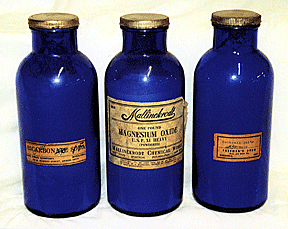 Youngstown,
Ohio, dentist Dr. Robert J. Durick found out the hard way that dealing
in old medicine bottles can have its consequences. On November 5, 2002,
eBay notified this prolific seller that he had been suspended from
buying or selling on their Web site for 30 days because he supposedly
violated their policy of not selling narcotics, steroids or other
controlled substances on their Web site. So Durick is suing eBay for $2
million. Youngstown,
Ohio, dentist Dr. Robert J. Durick found out the hard way that dealing
in old medicine bottles can have its consequences. On November 5, 2002,
eBay notified this prolific seller that he had been suspended from
buying or selling on their Web site for 30 days because he supposedly
violated their policy of not selling narcotics, steroids or other
controlled substances on their Web site. So Durick is suing eBay for $2
million.
This seemingly isolated incident raises some
questions about selling any sort of containers, mostly for their value
to advertising collectors, that contain some of their original contents–old
medicine bottles, household cleaners, insect sprays, poisons, etc. If a
container still has some of its contents, are those contents dangerous
or harmful to humans? If so, and a human is injured or killed from
ingesting the contents of an old medicine bottle, for instance, who is
responsible? And what does this have to do with the heightened terrorism
awareness since 9/11?
It’s the Law
According to Alan I. Roberts, president of the Dangerous Goods Advisory
Council in Washington, DC, laws governing the sale of containers with
flammable, corrosive or poisonous contents have been on the books since
1908, so they haven’t been enacted since 9/11, only more strongly
enforced. "The regulatory system places the burden on shippers to
properly classify flammable, corrosive, or poisonous materials they ship
or to determine that they do not meet any of the nine hazard classes as
defined by the regulations," he said. "While it’s likely
most of the bottles dealers and collectors are handling don’t contain
hazardous materials, I believe some will if, for example, they contain
medicine."
Cough syrups and other medicines often contain
alcohol which is classed as a flammable liquid. Roberts pointed out that
investigators make little distinction in regard to risk when they
discover violations of the regulations–and the penalties may be
severe.
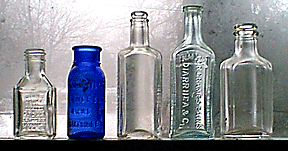 Nationally, it’s the responsibilities of the
Drug Enforcement Agency (DEA) to regulate toxic substances and
investigate violations. Rebecca A. Frierson, a pharmaceuticals
collectibles specialist with Liberty Antiques and Auctions of Newbury,
South Carolina, who has sold over 700,000 old bottles, always has a DEA
agent come in to inspect items before she they go on the auction block.
"One of the first things I do when I go into a new state to do an
auction, is contact the local DEA office and that state’s Department
of Environmental Control and invite them to my auction site so that they
can go through and identify any items that may be in violation of the
law," she said. "Though environmental laws vary from state to
state, the DEA law is national." Nationally, it’s the responsibilities of the
Drug Enforcement Agency (DEA) to regulate toxic substances and
investigate violations. Rebecca A. Frierson, a pharmaceuticals
collectibles specialist with Liberty Antiques and Auctions of Newbury,
South Carolina, who has sold over 700,000 old bottles, always has a DEA
agent come in to inspect items before she they go on the auction block.
"One of the first things I do when I go into a new state to do an
auction, is contact the local DEA office and that state’s Department
of Environmental Control and invite them to my auction site so that they
can go through and identify any items that may be in violation of the
law," she said. "Though environmental laws vary from state to
state, the DEA law is national."
In 1970, Congress passed the Controlled
Substances Act (CSA), Title II of the Comprehensive Drug Abuse
Prevention and Control Act, which became the legal foundation of the
government's fight against the abuse of drugs and other substances. This
law is a consolidation of numerous laws regulating the manufacture and
distribution of narcotics, stimulants, depressants, hallucinogens,
anabolic steroids, and chemicals used in the illicit production of
controlled substances.
Dangerous Substances
The CSA places all substances, regulated under existing federal law,
into one of five schedules. The law bases this placement on a
substance's medicinal value, harmfulness, and potential for abuse or
addiction. The DEA, which enforces this law, has posted these schedules
on its Web site. Schedule I is reserved for the
most dangerous drugs that have no recognized medical use, while Schedule
V is the classification used for the least dangerous drugs. The DEA is
most concerned about the drugs in Schedules 1 and 2, consisting of 185
drugs and their derivatives, such as codeine, morphine, coca, cocaine,
meperidine (Demerol), methadone, opium, pentobarbital, methylphenidate
(Ritalin). The lists include barbituates, amphedimines, cannabis,
anti-psychotics, transquilizers, muscle relaxers, and cough medicines.
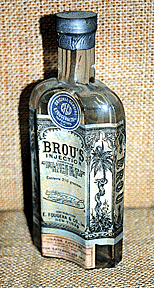 Under the law, the DEA may begin an
investigation of a drug at any time based upon information received from
law enforcement laboratories, state and local law enforcement and
regulatory agencies, or other sources of information. Under the law, the DEA may begin an
investigation of a drug at any time based upon information received from
law enforcement laboratories, state and local law enforcement and
regulatory agencies, or other sources of information.
"There’s a great concern about
substances getting out and made into dangerous cocktails, especially
from cough medicines," Frierson said. "The DEA doesn’t care
if a substance is 200 years old, especially if it’s included in their
Schedule II list. I’ve seen them go to antique shows, and if they find
dealers selling that kind of stuff, they shut them down."
Frierson noted that rules are a bit more lax
for poisons, such as strychnine and a deadly product called mercury
bi-chloride, formerly used as an anti-syphilitic and to clean wounds.
"This is nasty stuff, contains heavy metal, and is very
dangerous." Though she can sell bottles containing these
substances, they most likely fall within eBay’s category of
"controlled substances."
However, since 9/11, the DEA has pulled poisons
like cyanide, which Frierson frequently finds in another, more deadly,
form, off the market. Now she’s much more reluctant to put certain
substances on the market.
"Most pharmacies have expired stock and
keep it in a special place," said Frierson. "When I start
sorting through a pile of drugs in an old pharmacy, the drugs get older
and older as I get towards the bottom. That’s where I usually find the
earlier ones."
Frierson also said that many more drugs have to
be destroyed. She personally goes through all the items in a sale and
hand touches all the bottles to make sure they have no contents.
"There’s no problem selling the bottles as long as they’re
empty," she said. "And there’s still significant collector
value to a bottle without contents. There’s also a market for bottles
with contents."
Distribution Regulations
The CSA also creates a closed system of distribution for those
authorized to handle controlled substances. The cornerstone of this
system is the registration of all individuals and companies authorized
by the DEA to handle controlled substances. Registrants must maintain
complete and accurate inventories and records of all transactions
involving controlled substances, as well as security for the storage of
controlled substances.
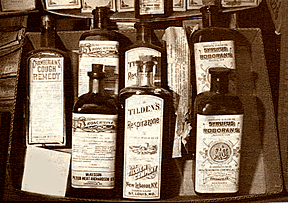 In the collectibles market, this goes both
ways. Frierson said that the narcotics law requires the substance in
question must be deleted from the seller’s inventory upon shipment and
added to the buyer’s inventory upon receipt of shipment. Each must
also have a secure storage facility. And both must be licensed by the
DEA to traffic in controlled substances. Any seller or dealer and buyer
or collector caught not obeying these requirements faces a heavy fine or
imprisonment. In the collectibles market, this goes both
ways. Frierson said that the narcotics law requires the substance in
question must be deleted from the seller’s inventory upon shipment and
added to the buyer’s inventory upon receipt of shipment. Each must
also have a secure storage facility. And both must be licensed by the
DEA to traffic in controlled substances. Any seller or dealer and buyer
or collector caught not obeying these requirements faces a heavy fine or
imprisonment.
Frierson uses reference books to see how a
substance is or has been used. This is especially important for
substances no longer in the Physician’s Desk Reference or for poisons
listed in Merck Manual. The above-mentioned mercury bi-chloride is a
good example. Widely used in the late 19th and early 20th
centuries, it’s no longer listed since it’s not used by doctors
today. "I constantly see information about sales through other
auctioneers who don’t have a clue as to what they’re selling,"
added Frierson. "I worry about substances people will use to get
high or perhaps die from."
What Collectors Collect
According to Frierson, collectors usually collect bottles made before
1920 for their shapes and those made after 1920 for what the bottle may
have contained. For example, there’s a market for bottles containing
substances with notoriety such as qualudes, which the government
outlawed because of their abuse. A bottle that contained them is worth
$15 to $50 for the nostalgic value alone, especially to those who abused
them. One person Frierson knows keeps Skittles in a former qualude
bottle on his desk.
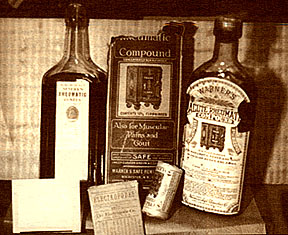 Some collectibles, like cereal boxes, are worth
more with their contents unopened, but this isn’t so with old medicine
bottles. Some collectibles, like cereal boxes, are worth
more with their contents unopened, but this isn’t so with old medicine
bottles.
Often collectors look beyond the bottle or the
contents and to the acquisition of one company over another such as
Mallencrot acquired by Merck and Co., which used to be Merck, Sharp and
Dohme. And before being Mallencrot, it was Powers and Weightman and
before that there was a Powers and a Weightman– all significant drug
companies. A very early pre-acquisition bottle can be worth
substantially more, according to Frierson. Some bottles are worth more
from the companies they came from than the contents they contained.
Frierson is annoyed at eBay since she sold the
empty bottles to Durick in the first place. One did have a little
phenobarbital in it, and Durick admits that it was his mistake for
selling it that way. "Bob Durick wouldn’t do anything
risky," said Frierson. "He normally doesn’t sell any
phenobarbital or barbiturates and neither do I."
<
Back to Collectibles Archives
Next Article >
|
